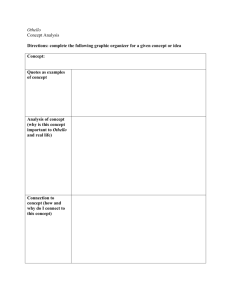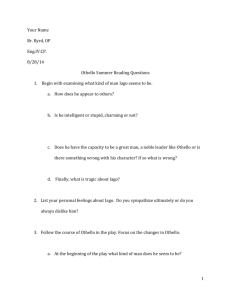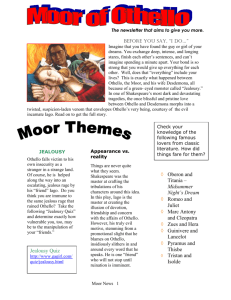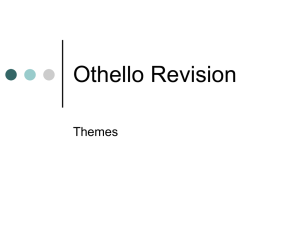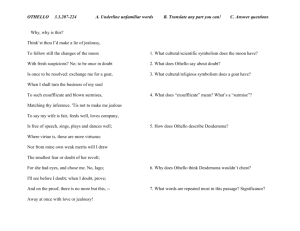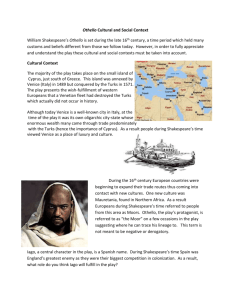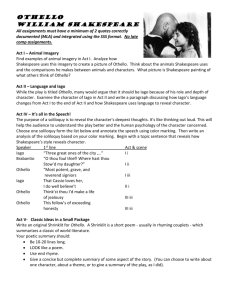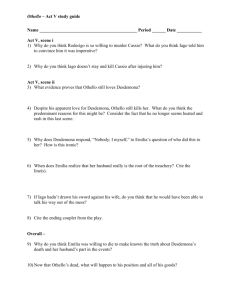Unit Plan Template
advertisement
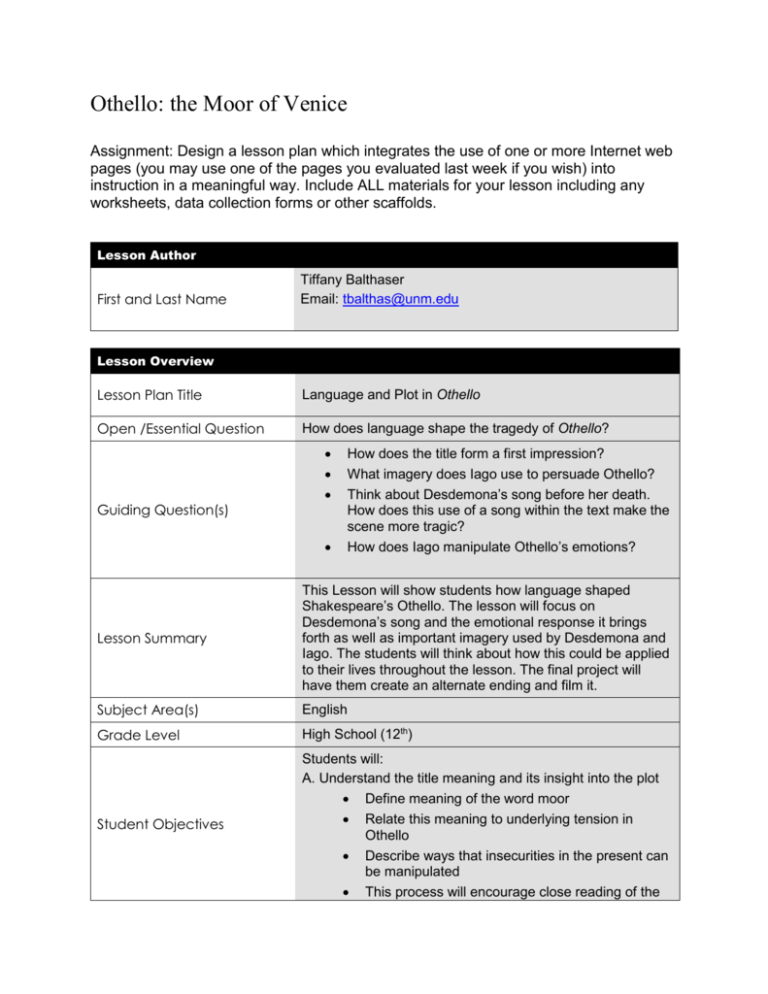
Othello: the Moor of Venice Assignment: Design a lesson plan which integrates the use of one or more Internet web pages (you may use one of the pages you evaluated last week if you wish) into instruction in a meaningful way. Include ALL materials for your lesson including any worksheets, data collection forms or other scaffolds. Lesson Author First and Last Name Tiffany Balthaser Email: tbalthas@unm.edu Lesson Overview Lesson Plan Title Language and Plot in Othello Open /Essential Question How does language shape the tragedy of Othello? Guiding Question(s) How does the title form a first impression? What imagery does Iago use to persuade Othello? Think about Desdemona’s song before her death. How does this use of a song within the text make the scene more tragic? How does Iago manipulate Othello’s emotions? Lesson Summary This Lesson will show students how language shaped Shakespeare’s Othello. The lesson will focus on Desdemona’s song and the emotional response it brings forth as well as important imagery used by Desdemona and Iago. The students will think about how this could be applied to their lives throughout the lesson. The final project will have them create an alternate ending and film it. Subject Area(s) English Grade Level High School (12th) Student Objectives Students will: A. Understand the title meaning and its insight into the plot Define meaning of the word moor Relate this meaning to underlying tension in Othello Describe ways that insecurities in the present can be manipulated This process will encourage close reading of the text to understand the author’s meaning. B. Understand how language moves the plot Effectively communicate how the language of Othello (especially the lies of Iago) influences Othello’s actions. C. Be able to recognize literary techniques used in Othello Describe the purpose and significance of Desdemona’s song. Recognize the imagery employed D. Be able to analyze the imagery and determine its significance to the plot E. Demonstrate a mastery of the plot Create an alternate ending which is realistic to the story Write a brief essay explaining why Shakespeare ending occurred (with textual support). Strand I: Reading Content Standard: Reading and understanding a variety of materials Benchmark I-A: Use comprehension strategies for unfamiliar vocabulary . Standards and Benchmarks Grade Performance: 1.Use etymology, the principles behind spelling and usage of words to determine meaning. 2.Differentiate shades of meaning and multiple meanings of words, including the significance of both connotation and denotation. 3. Analyze the context of sentences and larger sections of text to clarify the meaning of unknown or ambiguous words, detect nuances, make inferences and differentiate among possible meanings of words. 4. Analyze texts to identify specialized terminology or jargon needing clarification or definition. Benchmark I-B: Use comprehension strategies to understand the meaning of the text. Grade Performance: 1. Recognize and recall the use of literary devices and rhetorical modes in texts (e.g., illustration, classification, persuasion, comparison/contrast, cause/effect). Strand IV: Writing Content Standard: Students write effectively for a variety of purposes and audiences. Benchmark IV-C: Use formal or informal, literary or technical language appropriate for the purpose, audience, and context of the communication. Grade Performance: 1. Use language persuasively in addressing a particular issue. 2. Use grammatical, metaphorical or rhetorical devices to inform or persuade the reader. 3. Use knowledge of one’s subject and purpose to select appropriate language to communicate in writing. Strand VI: Logic Content Standard: Students employ critical thinking and abstract reasoning to make and assess inferences, conclusions, and predictions. Benchmark VI-B: Describe the structure of a given argument; identify its claims and evidence; evaluate connections among evidence, inferences and claims. Grade Performance: 1. Determine the significance and predict the possible consequences of a speaker’s arguments, conclusions, and proposals Benchmark VI- -E: Understand the distinction between a deductive argument and an inductive argument in order to evaluate an argument’s effectiveness. Grade Performance: 1. Analyze how stylistic and rhetorical devices, either inductive or deductive, support an argument by comparing the argument to the evidence. Strand IX: Literature Content Standard: Students read and interpret a variety of literature to develop an understanding of people, societies, and the self. Benchmark IX-E: Identify how elements of dramatic literature articulate a playwright’s vision. Grade Performance: 1. Evaluate the ways in which tension is created, maintained and resolved in a drama (e.g., catharsis, conflict, suspense, resolution), including through the text, directorial decisions, and through the actors’ performances. Assessment Student Assessment (include rubric) Students will work in groups to create a What if video ( an alternate ending to Othello). Students will individually write a 2-3 page essay which informs the reader why their alternate ending did not occur with support from the text. See rubric at the end of the lesson plan and additional instructions. Procedure (Include a Power Point with basic concepts for each step in the lesson plan) 1. Begin class by showing the Reduced Shakespeare Company Othello rap. (Link will be on Power Point) Link: http://www.youtube.com/watch?v=UCf0drvdmM 3 minutes Step-by-step Procedure (Includes facilitation questions throughout the lesson and all resources used in the lesson) 2. Say: Today we will be looking at the plot of Othello mainly focusing on language. Language in this context refers to how Shakespeare uses different literary techniques –especially imagery to advance the plot. Othello provides an important comment on how our words can affect others- how important language and the way we use it really is. The first thing we need to know to understand the play is the meaning of the title. Can anyone tell me what Shakespeare means by Moor? 3. Go over what a moor is. (Steps 3-6 should take a total of 35 minutes- facilitate in class discussion with questions) Define Moor. Ask how Othello being Moor would affect the plot? 1. Already insecurity in Othello because of his skin color. 2. Easier for Iago to manipulate Othello based on this insecurity (especially considering Cassio’s appearance). 3. If we have insecurities (even in the 21st century) isn’t easier to get to us by working off these insecurities? 4. Is Shakespeare giving his audience a message about our insecurities? 5. Tell me what you think by taking 5 minutes to write a response to this question. 4.Say: Please pass in your response papers. Now we are going to start to look at the language and literary techniques which Shakespeare uses. We will start by looking at Desdemona’s song in Act 4 Scene 3. Read the song as a class. As a class analyze the words of the song and the imagery used. 1. Focus on Willow imagery 2. The “softened stone” Ask: Why did Shakespeare use a song at this point with Desdemona? How would a song affect the audience? Show a clip from the movie to help the students realize the emotional impact of a song. Link: http://www.youtube.com/watch?v=4mlOCcpa7s Ask: How did seeing the song performed affect you? So based on how you reacted to seeing the song performed why would Shakespeare include a song? 1. Increase sympathy for Desdemona. 2. Allows audience to see her innocence and purity even as Othello is about to murder her. 3. Make the scene more tragic and thus has a greater affect on the audience. As a class analyze the words to the song and the imagery used. 5. Say: Iago is one of the most important characters, if not the most important in the development of the plot. Many of his lines utilize imagery in order to ignite in Othello extreme jealousy which leads to a horrible act of passion. As a class analyze a speech by Iago to Othello in Act 1 Scene 3. (lines 384-405) 1. “My fool my purse” (Use Othello for Iago’s gain) 2. “Sport and profit” (A game to Iago) 1. “Abuse Othello’s ear” (Lie to Othello) 2. “That thinks men honest that but seem to be so” (Thinks men are honest who are not-like Iago) 3. “As tenderly led by the nose as assess are.” (To trusting, like an unintelligent donkey) 4. “It is engendered.” (Taking form of life) 5. Hell and night must bring this monstrous birth to the world’s light.” (Darkness and evil bring this lie to light to bring down Othello) 6. Divide the class into groups of 3 and give each group a handout with a speech by Iago to Othello. Give each group about 15 minutes to analyze the speech. 1. Have them look at imagery employed. 2. The specific ways Iago manipulates Othello to become suspicious and jealous. 7. Have each group present to the class their speech and analysis. (about 2 minutes per group) 8. (Last 20 minutes of class). Say: So now that we have looked at a few key lines spoken by Iago I think we can see how influential Iago was in the plot. But what if Othello did not believe Iago? I want you to get into groups of five and for the remainder of class you are going to plan out an alternate ending to Othello. Your assignment for the weekend is to create a video of your alternate ending and present it to the class next week. I will give you each a rubric to let you know how this will be graded. Along with your video each of you will write a 2-3 page paper about why your ending did not come to be. Your paper will need to include textual evidence. Pass out rubrics and models. Say: The first sheet I gave you has a rubric for both the video and the paper. I have also given you a sheet with guidelines to assist you. Look over these guidelines they will help you as you work on these. I have also given you a sample of a paper that was written on Othello. This sample shows how you can include the evidence from the play in your essay and proper ways to cite. Do you have any questions? 9. Take the class to computer lab to storyboard their alternate ending. (This will not be graded it will just give the students a visual of how to plan out their video) At the computer lab direct them to this link: http://www.sotherden.com/video101/storyboard.htm Approximate Time Needed for lesson (Minutes, Days, Hours, etc) Go over each style (storyboard/script) and have the students pick the best one for them. Let the students create their storyboard to film. This should be done the last 20 minutes of class. One 90 minute class period (High schools are run on block schedules). Prerequisite Skills Needed Essay Writing Materials and Resources Required for Lesson Handouts of the lines the students will analyze (7 total) Internet connection “What If” & Paper Assignment Model What If Assignment: This assignment is meant to be completely creative. Since it is creative I am not going to give you a specific example on how to make this. However I have listed a few ideas that you can work of off and your rubric will also guide you in how to put this together. The videos should be about five to ten minutes in length (under five minutes and over ten will result in a deduction of points). Be considerate of your audience when making this video. Outside of school you will need to be considerate of your audience if you are making any type of presentation (which we all need to do at least once) so this good practice to stick to a timeline while still getting across the important information. Everyone needs to have a role in this film and credits need to be included at the end. This alternate ending is completely up to you. That being said it should be realistic i.e it should be plausible within the plot (aliens cannot come down to change the outcome). To get started think about what would have happened if: o Desdemona had taken a less passive role in her murder? o Iago had a change of heart or a different motivation to keep Othello alive? o Cassio had discovered the truth? o Othello realized the inadequacy of the “evidence Iago provided” Paper: These papers are to be written individually. They must have a introduction, thesis, and conclusion, and must include support from the text we have looked at. I have included a few examples of how to write a paper citing Othello. Your papers need to be two-three pages in length. Your introduction should include a summary of your alternate ending plot. Your thesis should inform the reader why your alternate ending did not actually come to be. The body of your paper needs to have textual support Cite your source in MLA format and include a bibliography. *These assignments will be your assessment for Othello so make sure that you spend quality time on each of them! Video Rubric 5 3 1 Creativity The video is creative and unique in its approach to an alternate ending. The alternate ending is plausible. The video is creative, however the ending is not completely plausible. The video does not provide an alternate ending that is plausible. OR The ending is does not provide difference from the orginal. Group involvement Everyone in the group has an equal role. The roles in the film/film making are not even. Not everyone has a role in the film/film making process. Script The script is well written and the story is easy to follow for the audience. Shakespearean language is used throughout. The audience is entertained throughout the video. The script does not always flow, there are some places of confusion. Shakespearean language is sometimes used. The audience begins to lose focus during the video. The script does not make sense. The language used is mostly modern. Within the 5 to 10 minute length. The video goes over or under the time limit by 30 seconds to 1 minute. The video goes over or under the time limit by 2 minutes. Entertainment Quality Length The audience cannot pay attention to the movie and are uninterested in the plot. Paper Rubric Format Support of Thesis Grammar/Spelling Transitions 5 Includes an introduction with a clear thesis & conclusion. The thesis is supported throughout the paper with properly cited evidence from the text. Little to no grammar and spelling mistakes. Transitions from paragraph to paragraph flows. Ideas connect. 3 Introduction and conclusion are included however the thesis is not clear. The thesis is supported in the paper, however there is little evidence from the text. Not in proper MLA format. Grammar and spelling errors appear occasionally. Transitions are mostly smooth. Some transitions are choppy, ideas do not always connect. 1 The paper lacks introduction and conclusion. Thesis is not discernable. The thesis is not supported with any evidence from the text. No citations. Many grammar and spelling errors. Transitions are choppy and ideas do not connect. Lesson Plan adapted from: Willard, David. Three-Day Othello Unit: Lesson 2. Web. 17 April 2011. http://www.lessonplanspage.com/LACI3DayOthelloUnit912.htm Bibliography Guralnik B. David Joseph, Friend H. Webster's New World Dictionary. College ed. 1957. Print. Parker, Oliver. Othello. Video. 1995. Web. 24 April 2011. http://www.youtube.com/watch?v=4mlOCcp-a7s The Reduced Shakespeare Company. The Complete Works of William Shakespeare Abridged: Othello Rap. Video. You Tube. 24 July 2006. Web. 24 April 2011. http://www.youtube.com/watch?v=UC-f0drvdmM Shakespeare, William. Othello, the Moor of Venice. The Complete Works of William Shakespeare. Ed. David Bevington. Sixth ed. New York: Pearson, 2009. 1150-200. Print. Skandera, Hanna. "New Mexico Content Standards with Benchmarks and Performance Standards." Web. 19 Apr. 2011. http://www.ped.state.nm.us/standards/ Sotherden, Bryan. "Pre-Production Storyboard." Www.LearnLicks.com. Web. 20 Apr. 2011. http://www.sotherden.com/video101/storyboard.htm

